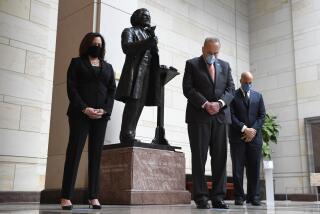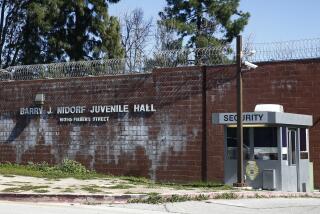State Analyst Says Costly Plan to Hire Police Is Falling Short
- Share via
SACRAMENTO — Gov. Pete Wilson’s touted $100-million program to put more cops on the street apparently is not meeting its goal, the legislative analyst’s office reported Wednesday.
Moreover, the analyst’s office said it’s impossible to tell how the money has been spent--even though the state required that local agencies produce 7,500 reports detailing where the money went.
Wilson began pushing for the program during his ill-fated presidential campaign, then called for the $100-million expenditure as part of his 1996 State of the State speech.
At the time, he declared that the money could put “hundreds more police officers on our streets and prosecute and jail juvenile thugs who now go unpunished.”
At Wilson’s urging, the Legislature approved the so-called COPS program as part of last year’s budget. In his budget proposal for this fiscal year, Wilson is urging that another $100 million be spent to continue the program.
However, in a report on Wilson’s proposed $66-billion state budget for the fiscal year starting July 1, the nonpartisan legislative analyst found that local officials used the money for one-time purchases, not for more officers.
They did so, the analyst said, because they were not certain they would continue to receive future funding from the program.
“Specifically, there is no ongoing mechanism for evaluating the effectiveness of COPS expenditures or sharing this information with other local governments,” Legislative Analyst Elizabeth G. Hill’s report said.
Alameda and Contra Costa counties, for example, used the money to lease a police helicopter. The city of Menlo Park spent $71,000 to buy 17 laptop computers and three mobile radar units.
The state allocates the COPS money based on population, so Los Angeles County received roughly a third. Under the state formula, local government was supposed to spend 75% on police, 12.5% on prosecutors and 12.5% on jails.
“We’re confused by the statements made by the legislative analyst,” said Sean Walsh, Wilson’s spokesman. “This is a well-balanced, comprehensive law enforcement initiative. It is $100 million that is helping drive the crime rate down to its lowest level in nearly 30 years.”
The legislative analyst did find some locals that used the money to hire more police officers and deputies.
But in some instances, the local agencies hired temporary officers. Others used the state money to comply with federal requirements that they match grants from the Clinton administration for more police.
The Los Angeles County Sheriff’s Department, for example, used $2.3 million of the state money to match its federal grant to hire 152 deputies, said Marianne O’Malley, the analyst who studied how the $100 million was spent.
Marin County apparently was an exception. It used the state money to hire two deputies.
In many instances, O’Malley could not determine how cities and counties, including Orange County, spent their money. The reason, she said, is that “unfortunately, there is not one single composite report” detailing how California’s 5,000 police agencies used the money.
Instead, the state imposed requirements forcing police agencies to document internally and to local city and county treasurers how they spent the money, often on a monthly basis. Agencies that received the money were required to prepare a combined 7,500 reports on how they spent it.
The analyst’s report recommended that the Legislature make significant changes to the program, such as awarding the money on a competitive basis and requiring agencies to document the effectiveness of their programs.
The legislative analyst made several other recommendations about Wilson’s proposed criminal justice spending plan:
* Citing continued problems with inmate abuse by guards and turmoil among staff in prisons, the legislative analyst called for an independent inspector general to investigate problems in the prison system.
The analyst noted that litigation from staff and inmates is costing California $35 million this year, a 14% increase over the past two years. An independent inspector general housed in the Youth and Adult Correctional Agency, rather than internal affairs officers at individual prisons, could root out problems and reduce the cost to the state, the report said.
* The Department of Corrections should immediately institute psychological testing of all potential new employees. A law already requires such screening, but it hasn’t been done because of the cost, the report said. The screening process for recruits would cost about $2 million a year.
* Although the prison population, now at 145,000, will reach 204,000 by 2002, the rate of increase continues to slow, prompting the legislative analyst to recommend that the Legislature withhold approval of Wilson’s proposal to fund three new prisons.
On Wednesday, the Department of Corrections announced it plans to implement psychological screening for recruits, and will establish an inspector general who will report to the head of the agency.
Craig Cornett, the analyst in charge of the LAO’s criminal justice team, attributed the slowing rate of increase in prison population to a decline in the crime rate, largely because of a demographics: there are fewer young men in California who commit most crimes. He also said anti-crime legislation passed in recent years may be having a deterrent effect, although that is difficult to prove.
More to Read
Get the L.A. Times Politics newsletter
Deeply reported insights into legislation, politics and policy from Sacramento, Washington and beyond. In your inbox three times per week.
You may occasionally receive promotional content from the Los Angeles Times.










